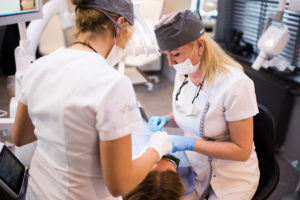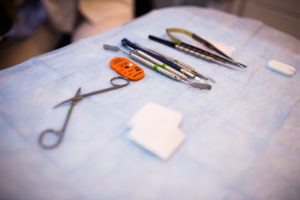 Gingival recession, i.e., retraction of the gingival margin with the simultaneous exposure in the roots of teeth are quite common problems leading to diminished cosmetic appeal in a given area and sensitivity of the exposed root surfaces. Gingival recession can be caused by improper brushing, incorrect tooth position and overloading, as well as by dental treatment complications. Properly performed surgical treatment helps improve esthetics and reduce the sensitivity of teeth affected by recession.
Gingival recession, i.e., retraction of the gingival margin with the simultaneous exposure in the roots of teeth are quite common problems leading to diminished cosmetic appeal in a given area and sensitivity of the exposed root surfaces. Gingival recession can be caused by improper brushing, incorrect tooth position and overloading, as well as by dental treatment complications. Properly performed surgical treatment helps improve esthetics and reduce the sensitivity of teeth affected by recession.
Surgical treatment of gingival recession involves covering the exposed root fragment by moving the mucous membrane from the recession area and the mucous membrane transplant. The most common types of transplantation are mucous membrane graft, free gingival graft, and subepithelial connective tissue graft.
Free Gingival Graft (FGG) is a full-thickness transplant of the flap containing connective tissue and a mechanically resistant keratinized epithelium. A graft is taken from the hard palate mucous membrane if there is no keratinized epithelial zone around a tooth with recessive gum. In this way, it is possible to create a proper attachment of the gum to the tooth and ensure proper resistance of periodontal tissues to mechanical injuries, such as those occurring during chewing or brushing teeth.
 Subepithelial Connective Tissue Graft (SCTG) is harvested from deeper layers of the hard palate mucosa and contains only connective tissue. This technique involves covering the surface of the exposed root if gums require thickening. This treatment improves the mechanical resistance of the gingiva and ensures its stability in a new position, preserving recession coverage.
Subepithelial Connective Tissue Graft (SCTG) is harvested from deeper layers of the hard palate mucosa and contains only connective tissue. This technique involves covering the surface of the exposed root if gums require thickening. This treatment improves the mechanical resistance of the gingiva and ensures its stability in a new position, preserving recession coverage.
Appropriate treatment technique is individually chosen by the surgeon. Before the procedure, we properly diagnose and eliminate recession causes in order to prevent its recurrence. All procedures are performed by qualified doctors with the use of modern surgical techniques to ensure minimal invasiveness and proper postoperative healing.